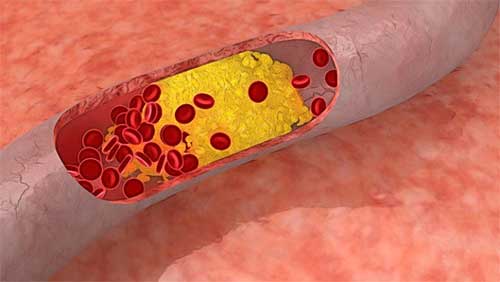Atherosclerosis : Causes, Symptoms, Prevention and Treatment
Modern science, technology, and development have no doubt made our life more comfortable and has doubled the life expectancy. But the changing lifestyle, sedentary habits, stress and unhealthy eating have gifted us the disease of modern civilization, and that is atherosclerosis. In this article, we will cover all the topics related to atherosclerosis like how atherosclerosis develops, its causes, symptoms, risk factors, test, diagnosis, treatment, preventive measures and diet and lifestyle changes that can keep atherosclerosis at bay.
What is Atherosclerosis
Atherosclerosis is narrowing of the arteries carrying oxygen and nutrients from the heart to the other body parts. There is thickening of the artery that slowly block it partially or entirely reducing the blood and oxygen supply to the vital organs.

What is atherosclerosis
Atheroma that is made up of cholesterol, fats and other substances such as calcium, fibrin, and cellular waste products on the walls of artery blocks the arteries is known as plaques. Atherosclerotic plaque development increases the risk of blood clot and may result in the stroke, heart attack and peripheral vascular disease.
How Atherosclerosis Develops
Development of atheroma is a complicated process. The exact cause is unknown, but it is considered that the damage to the endothelium results in the formation of atherosclerotic plaque. High blood pressure, high level of cholesterol in the blood and smoking are factors considered to cause the damage.

How atherosclerosis develops
Atherosclerosis not only affects the heart but may change the arteries of any body part. It affects just medium-sized and large.
What are the Causes of Atherosclerosis
Common Causes of Atherosclerosis are as follows:
1. High Cholesterol-
High level of cholesterol in your blood is an essential cause of atherosclerosis. It is a waxy, yellow substance naturally occurring in the body and certain foods. When the level of cholesterol in the blood rises, it accumulates on the innermost layer of the arterial wall and clogs the arteries. Eventually, it gets hard, and blocks and the circulation of the blood to the heart and other body organs decreases.
2. Fat-
Excess of fats too gets accumulated in the arteries and contributes to the plaque formation.
3. Aging-
Atherosclerosis is a slowly progressing disease that may even begin in the early childhood and progresses rapidly after 30 years of age.
With age advances, the blood vessels and heart work hard to pump and receive the blood due to the weakening of the arteries and decreased the elasticity of the arteries decreases and become susceptible to the formation of the plaque.
4. Smoking-
Smoking speeds as well as aggravates the growth of atherosclerotic plaques in the aorta, coronary arteries and the arteries of your legs.

Smoking
Individuals at the Risk for Atherosclerosis
Thera is many factors that are responsible for increasing the risk for atherosclerosis such as family history, lack of exercise, an improper diet rich in fats saturated fats and cholesterol. Smoking, high blood pressure and diabetes.
What Are the Symptoms of Atherosclerosis
Symptoms of atherosclerosis may not be displayed until and unless a blockage occurs that disrupts the flow of blood.
Common symptoms of atherosclerosis are chest pain, pain in legs, arms, fatigue, shortness of breath, confusion, weakness of leg muscles. The signs of stroke and heart attack that may be caused due atherosclerosis as both are life-threatening conditions and require immediate medical attention.

What Are the Symptoms of Atherosclerosis
Symptoms of a heart attack are Chest pain radiating to shoulders, neck, arms, jaw, and back, pain in the abdomen, shortness of breath, sweating, lightheadedness, restlessness and nausea and vomiting.
Symptoms of stroke are numbness in the limbs or face, weakness of the legs, Speaking problem, Vision problems, severe headache and loss of balance.
Diagnosis of atherosclerosis
To diagnose atherosclerosis physical examination done by your doctor includes weakened pulse, aneurysm, slow wound healing that indicates a disrupted blood flow, abnormal heart sounds.
Tests that are conducted includes:
To check atherosclerosis, your doctor will recommend you a blood test to check blood cholesterol level. Doppler ultrasound is done to rule out any blockage. Other tests are Ankle-brachial index test magnetic resonance arteriography Computed tomography angiography, Cardiac angiogram, Electrocardiogram (EKG) and an exercise tolerance test.
Treatment of atherosclerosis
Besides specific medication, the treatment of atherosclerosis mainly includes changes in diet and lifestyle. You need to limit the intake of fat and cholesterol-rich food along with practising exercise and yoga. This will improve the health of the heart and the blood vessels. Also, it slows or stops the growth of plagues. In some cases of aggressive treatment, the diseases may also shrink slightly
The additional medical treatments include medications that prevent the worsening of atherosclerosis. They include cholesterol-lowering medications- Statins and fabric acid derivatives, anticoagulants and antiplatelet drugs, anti-hypertensive drugs- calcium channel blockers, diuretics, or water pills, angiotensin-converting enzyme (ACE) inhibitors and thrombolytic therapy1
If symptoms are severe, surgery is needed. Possible surgeries include:
Bypass surgery-
In this, a healthy blood vessel, usually from the leg or chest is used to divert the blood around the narrowed artery
Angioplasty-
It is surgical unblocking of the artery
Endarterectomy-
In this, a part of the inner lining of an artery is removed surgically along with the obstructive deposit.
Atherectomy-
It is a minimally invasive surgery to eliminate the atherosclerosis plagues from the blood vessels.
Prevention of atherosclerosis
Atherosclerosis is to some extent preventable by bringing changes in the lifestyle and eating habits. If you are obese, try to reduce your weight. Stay active to improve blood circulation and enhances the development of new blood vessels. Eat foods rich in cholesterol and fats. Shift on to healthy fats that is polyunsaturated fats. Avoid saturated fats and transfats.

Prevention of atherosclerosis
Limit salt intake and refined sugar. Add complex carbohydrates, fresh fruits, and vegetables to your diet. Avoid alcohol. Drink 8-9 glasses of water every day. Quit smoking. To reduce stress try meditation, breathing exercise and yoga.

















































